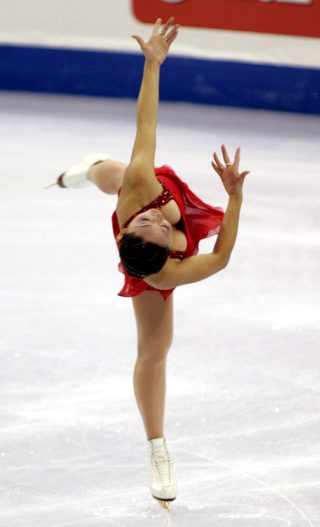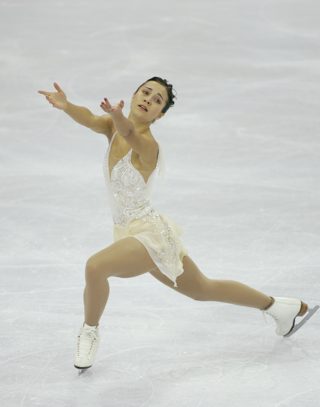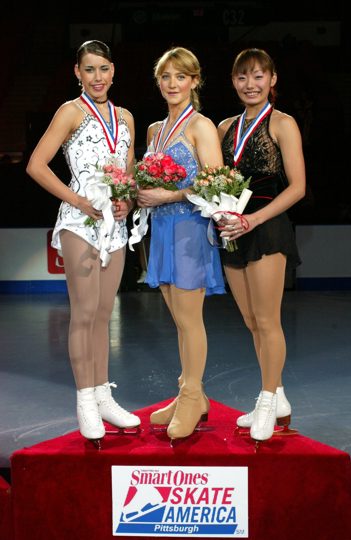|
The 16 year old Japanese champion rocketed into a triple Lutz to triple loop combination set to music called Gypsy Soul. The majority of the judges thought that the three sections of this incredibly difficult move (the approach and entry into the move; the actual jumps and positions in the air; and the landing and quality coming out of the move) were quite satisfactory. One judge even gave a plus two but another saw what others didnít and pressed the minus one button. All of her elements were executed without apparent error but the spiral sequence was not up to the standard of the rest of the elements and eight of the judges punched in minus figures. Through an interpreter, Ando said she was nervous because she had drawn to skate first. Skaters have always expressed fear of drawing to skate early in a large field. When the 1999 Russian world champion Maria Butyrskaya drew to skate early for the short in the 1998 Olympics, she publicly burst into tears. She believed judges would save their high marks for later skaters. As the competition progressed and the judgesí warmed up, they would forget her efforts. She was mistaken. The judges did not overlook her and she finished third out of 30 in the short. The policy of staggered draws was implemented because of fears like this. Once an order is established in an earlier round, the draw is done in groups so the top six skate in the last warm-up group. In any case in a field of eleven, judges would hardly become so overwhelmed they forget earlier efforts. And one of the selling points of the new system is that this whole discussion is irrelevant because the officials are no longer ranking individuals, merely passing judgment on how each move or program component has been executed. Ando, who is from the commuter community of Aichi, which is close to the big cities of Kobe and Osaka, is trained by Kumiko and Nobuo Sato, the parents of 1994 world champion, Yuko Sato. Ando was given credit from the ISU for landing the first quad by a woman (a Salchow) in an international, which she accomplished at the Junior Grand Prix Final in The Hague in December 2002. However, she has not landed the feat cleanly again in competition. Ando said, through an interpreter, "Iím glad to skate here but, if Iím competing in the U.S., they are interested in more than my jumps, and I wasnít confident about my expression. Compared to Michelle Kwan, I donít feel confident about my expression. Being here I felt like other people gave me courage, saying they like my smile, and the audience is very nice, and that encouraged me. So, now, I feel okay even while I made a mistake in the beginning Angela Nikodinov, who made the US world team in 1999, 2000 and 2001, finishing fifth in her last appearance, performed to Beethovenís Moonlight Sonata. She was awarded almost no minuses, considerably less than Ando. However, her triple Lutz to double toe had a technical value of 7.3 as compared to Andoís combination which was worth 11.0. Nikodinov confessed, "My footwork didnít look at all like it should tonight, but nobody can be perfect in October. You go home and work on what you donít feel comfortable with." Nikodinovís second place proved she is on the comeback trail. She is now training with Igor Pashkevich in Lake Arrowhead, on the same rink as Kwan. "Michelle and I get along really well. Weíre both the same age, 24. I really respect her. "Last year, because of my injury, I didnít start training till October. I started competing in Grand Prix events when I was 17 but this is my first one in two years. I walked in and I didnít know anyone. There were all these youngsters. "It was great to see Elena (Liashenko, from Ukraine, who is 28) because we have competed against each other. But itís not about age. Thereís no deduction for age. Itís about who can put those triples on the ice. "It felt good to get the first program of the new season out of the way. Itís a hard competition. With the new system Iím thinking about the new levels in the spins and elements. When I saw my scores, I had no idea what it meant. "Before, we were just doing the elements. Now weíre counting positions in spirals and rotations. "I donít often get injured but when it happens, itís serious. I went through some personal problems when my coach passed away just before the Olympics. And then I was off the ice for seven months after my shoulder surgery which is pretty long for a competitor. But things like that make you stronger. "I didnít want to watch my rivals out there while I wasnít skating. I had doubts about coming back. It was difficult to stay in shape and, mentally, you start doubting yourself. Everyone goes through that and I started asking, ĎWhy am I doing this to myself?í But then I found I canít live without skating. There is a two-way tie for third place between the Canadian champion, Cynthia Phaneuf, 16, and Alissa Czisny, 17, who only heard on October 17 that she was to report in for this event. Fortunately, she had just taken part in Regionals and was in full training. "I was exhausted from Regionals but itís an honor to be invited. I wasnít expecting it and was a little afraid. I wasnít really nervous. Iím very excited to be here. I didnít expect to be in third." Czisny, who is the elder of twins born 12 minutes apart, was runner-up for the US junior title in 2001 and had been in US nationals at senior level for three years (finishing 11th, 10th and 12th). Her sister also skates but was injured and is now looking for a dance partner. Czisny gave a very balletic performance to The Mission. She is trained in Bowling Green by Julianne Berlin. Her triple flip became a double and her triple Lutz to double toe had some minuses. Phaneuf, who is trained by Annie Barabe, has grown considerably this year which has resulted in problems with jumps. In Pittsburgh she completely popped her triple flip which was recorded as a single and was given the lowest rating of minus three from all the officials. "I was off balance. It just takes time to get used to my new body," Phaneuf explained. However, Phaneuf completed all her other elements including a triple Lutz to double toe combination to Dvorakís haunting music, ĎSongs My Mother Taught Meí. "I will do the flip next week in Skate Canada," Phaneuf promised. Yukino Ota, a 17 year old from Kyoto, who won the 2003 world junior title and the Four Continents Championship earlier this year, injured her right ankle in September. Skating to Ravelís Tzigane, her triple Lutz to double toe was classed as a double to double, and she took fifth place. Liashenko, who has competed in the world championships for many years with a best placing of sixth in 2002, popped her triple flip and was sixth. Seventh was the Australian Miriam Manzano, a 29 year old who has made the world championship team for the past three years (best place 16th in 2002). Manzano used the music Enchanted Nymph by Levitsky. She doubled her triple flip and had a 1.0 deduction for a time violation. The 22 year old Susanna Poykio, from Oulu in Finland, who finished 12th in the 2004 worlds, skated to Camille Saint-Saensí Henry VIII but had several mistakes. Her triple flip became a double, and her triple Lutz to double toe, was classed as a double-double. Her double Axel received unanimous minus ones. Twenty one year old Anne Sophie Calvez from France, who was 17th in her third world championship last March, began with a triple toe loop to triple toe loop combination which was awarded mostly minus scores. She fell on her triple flip which means she not only received minus threes, she got a 1.0 deduction. Taking tenth place was Idora Hegel, 21, of Croatia, who was 16th in the 2004 worlds, which was her fifth entry. She fell on her triple Lutz which was to be her combination and had minuses on her triple loop and spiral sequence. In last place was Fan Dang, 16, from Harbin in China. She singled her double Axel, turned her triple Salchow into a double and had other errors. |
||||||||||||||||||||||||||||||||||||||||


